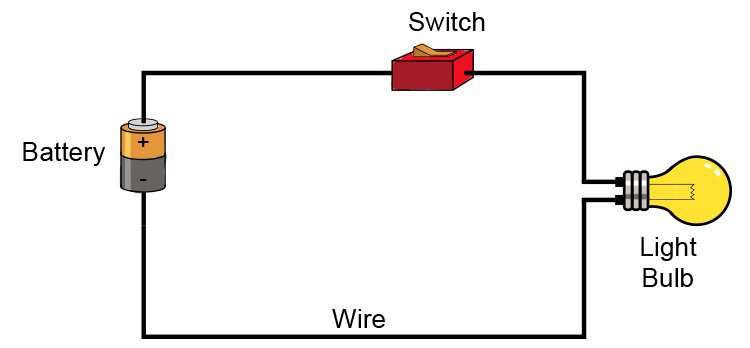Back to: BASIC TECHNOLOGY JSS3
Welcome to class!
In today’s class, we will be talking about simple electrical wiring. Enjoy the class!
Simple Electrical Wiring

Introduction
When electronic devices are connected to a source of electric power in a way that electric current flows through them and back to the sources, an electric circuit is formed.
Electric circuits
An electric circuit is a complete path through which electrons or current flows. The path is made up of cable or wire which connect all the components of the circuit.
Components of an electric circuit
- Battery: It is the means through which there is a flow of electrons in the electric circuit. It is measured in Amperes (A).
- Resistor: This is a device which is used to limit the free flow of electrons or to provide a voltage drop in the circuit. It is measured in ohms (Ω).
- Load: This includes the lamp and other electrical appliances connected to the circuit. E.g. radio, television sets, etc.
- Control: This refers to the electric components that are used to switch “on” and “off” current. E.g. fuses.
Types of circuit
- Series circuit: In a series circuit, the same current flows from the positive terminal of the battery through accessories and back to the battery through the negative terminal.
- Parallel circuit: In a parallel circuit connection, there is more than one path through which current flows into the circuit. Each accessory draws its current from the battery.
NOTE: The addition of another bulb will not reduce the brightness of the lamps because different current flows through each lamp, and the current in each bulb is independent of the other.
Wiring tools, materials and accessories
The tools used for the electric wiring and installation of circuits in the homes, offices and other building structures and equipment are called wiring tools.
Common tools used in electrical wiring include tester, plier, fishing tape, hacksaw, screwdriver, knife, hammer, cutter, spirit level, gimlet, pipe-bending machine and the ohmmeter.
Uses of wiring tools
- Testers: It is used to detect the presence of electric current.
- Pliers: It is used to hold, twist and cut cables during wiring.
- Fishing tape: It is used to draw wires through conduit pipes.
- Hacksaw: It is used to cut pipes in conduit wiring.
- Screwdriver: They are used to drive in screws to hold accessories onto surfaces.
- Hammer: It is used to drive in wiring nails which holds the clips.
- Cutter: It is used to cut cables and wires.
- Spirit level: It is used to check the straightness of aid cables, especially in surface wiring.
- Bending machine: It is used to bend conduit pipes.
- Ohmmeter: It is used to test the continuity of wiring.
Electrical accessories/materials used in electrical wiring
- Joint boxes
- Lamps
- Lamp holders
- Distribution bases
- Socket outlets
- Switches
- Ceiling roses
- Screws
- Clips
- Nails
- Cables
- Conduit pipe
Wiring systems
There are two main types of wiring systems viz:
- Surface wiring: In this type of wiring, the cables are laid on the surface of the walls.
- Conduit wiring: The cables are inserted into the metal or P.V.C. (polyvinyl chloride) tube within the wall.
Safety regulation in electrical wiring
- Switches for the bathroom should be installed outside the bathroom.
- Always switch off circuits before working on them.
- Never use your teeth to strip insulations from cables.
- Current-carrying conductors must never be left exposed. Use cello tapes to cover up exposed joints.
- When working on live circuits, always use well-insulated tools.
- Use appropriate sizes of and ratings of accessories in all installations.
We hope you enjoyed the class.
Should you have any further question, feel free to ask in the comment section below and trust us to respond as soon as possible.

Why Cant i Answer Quiz
I love the teaching